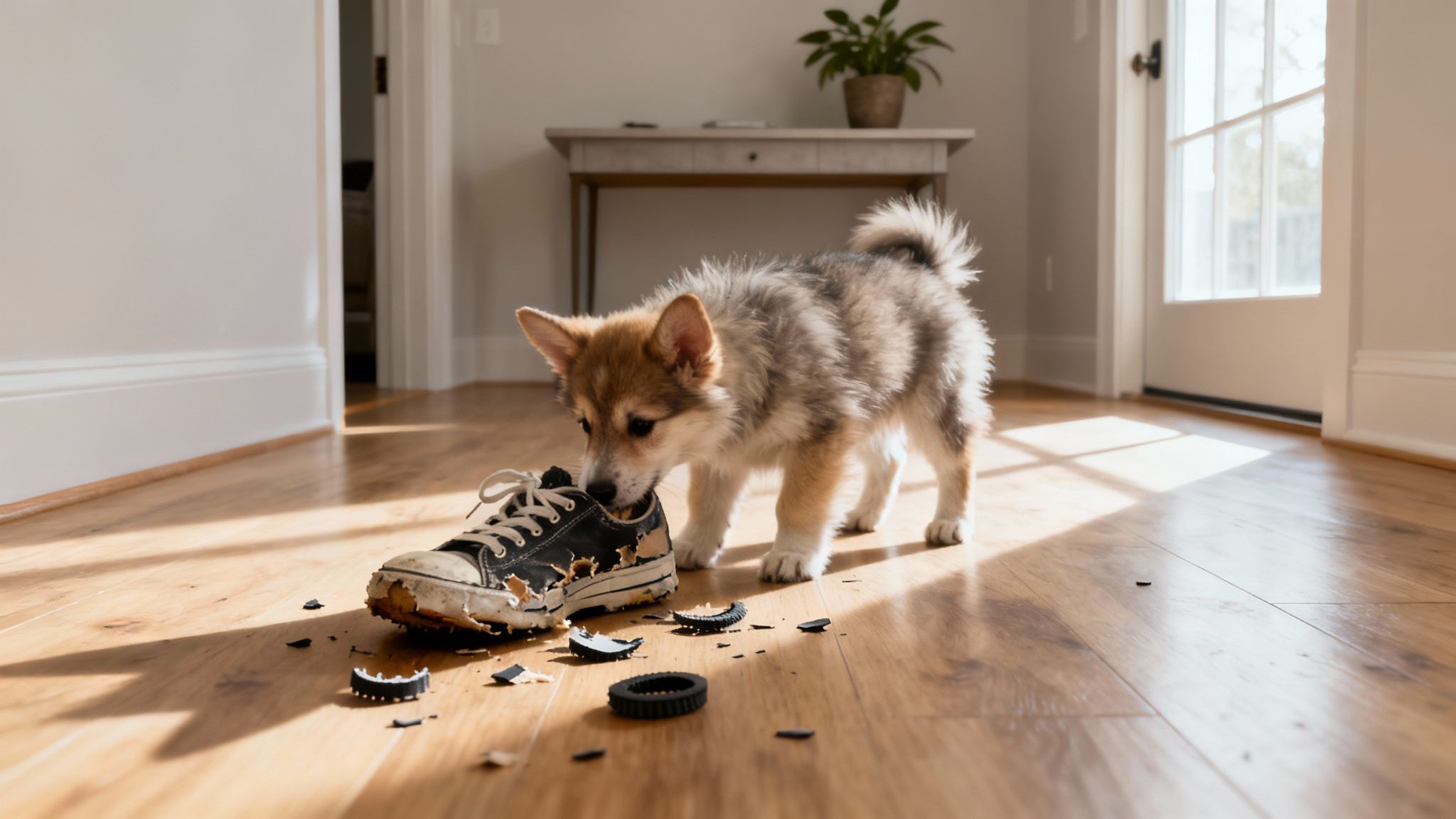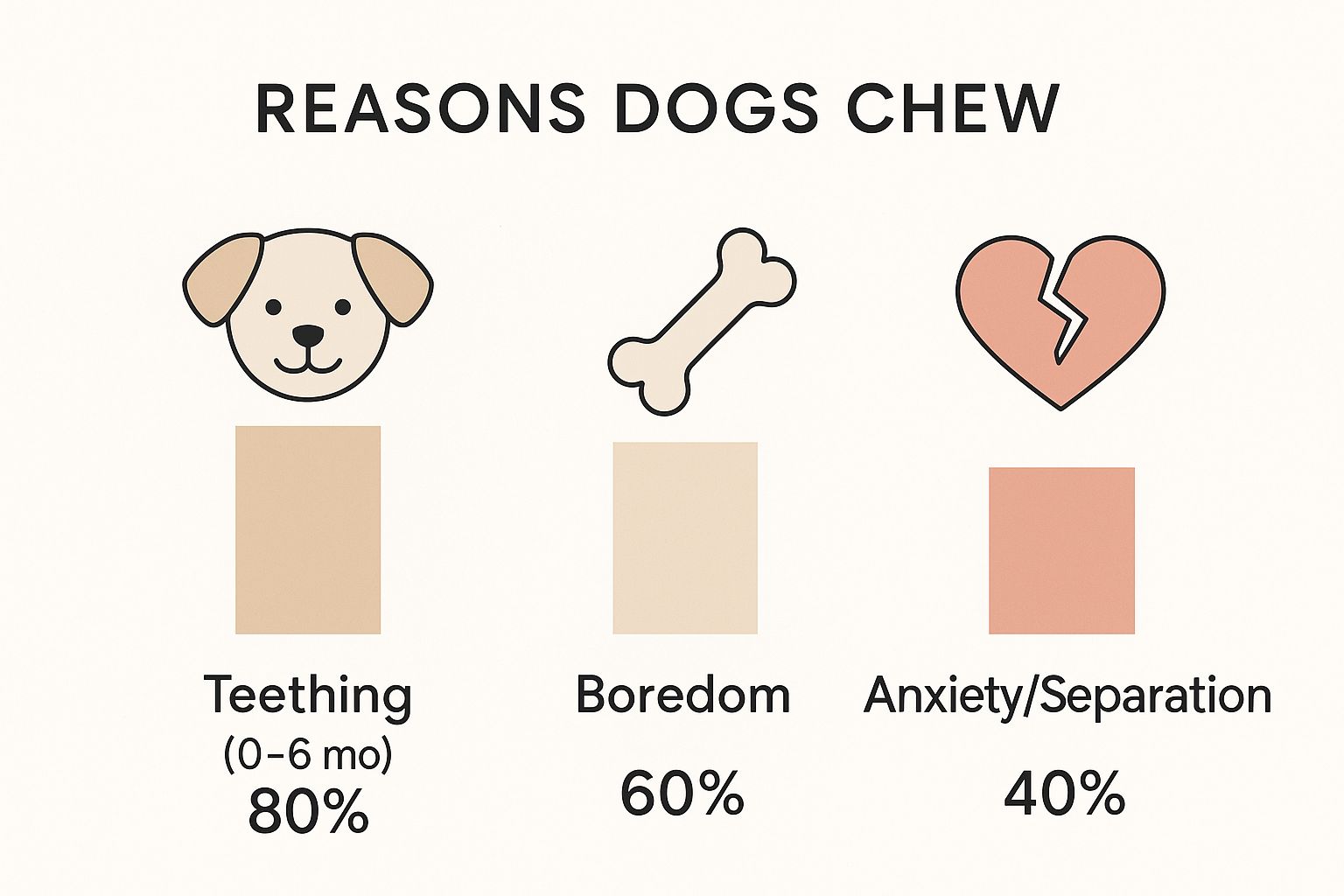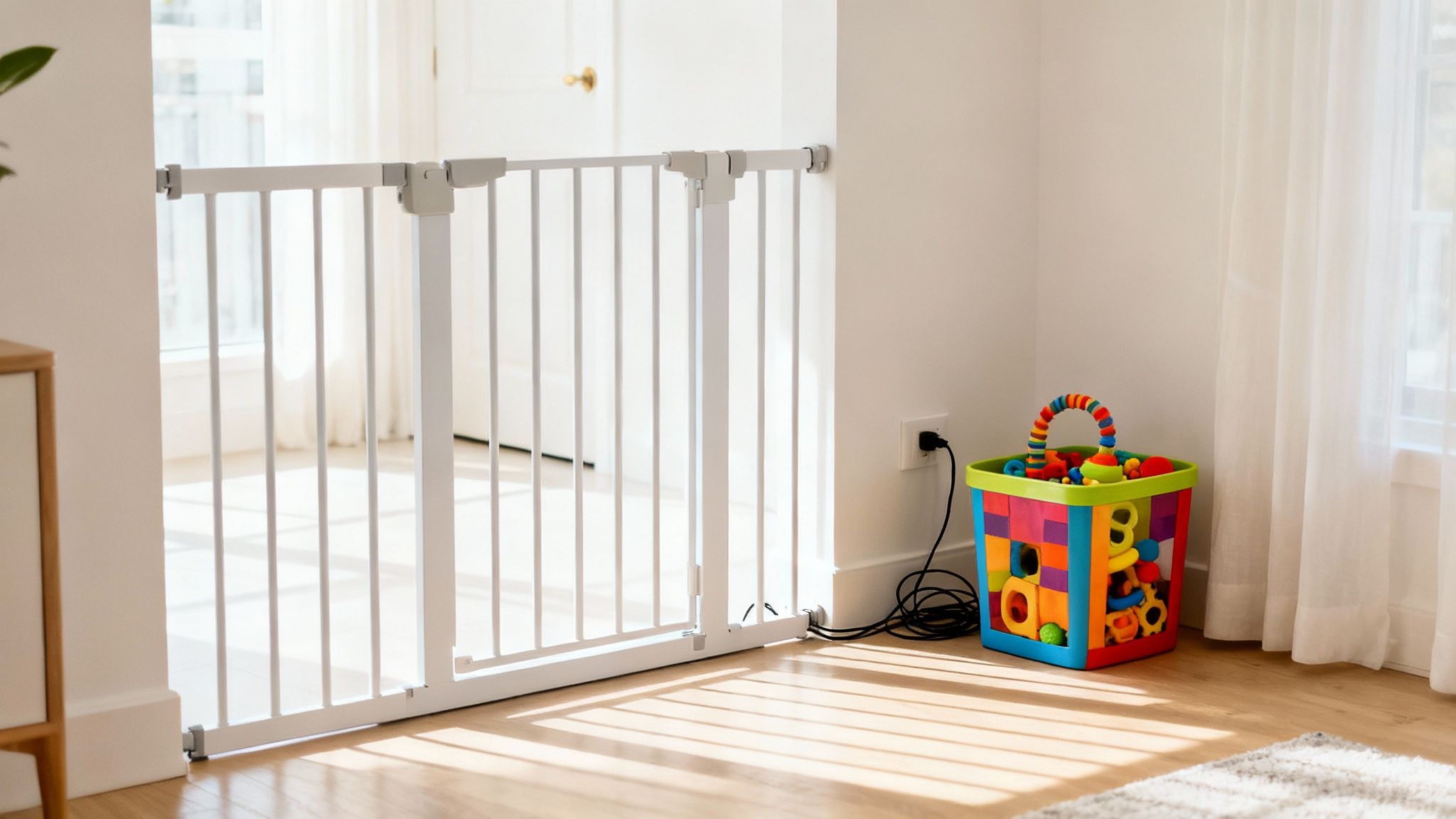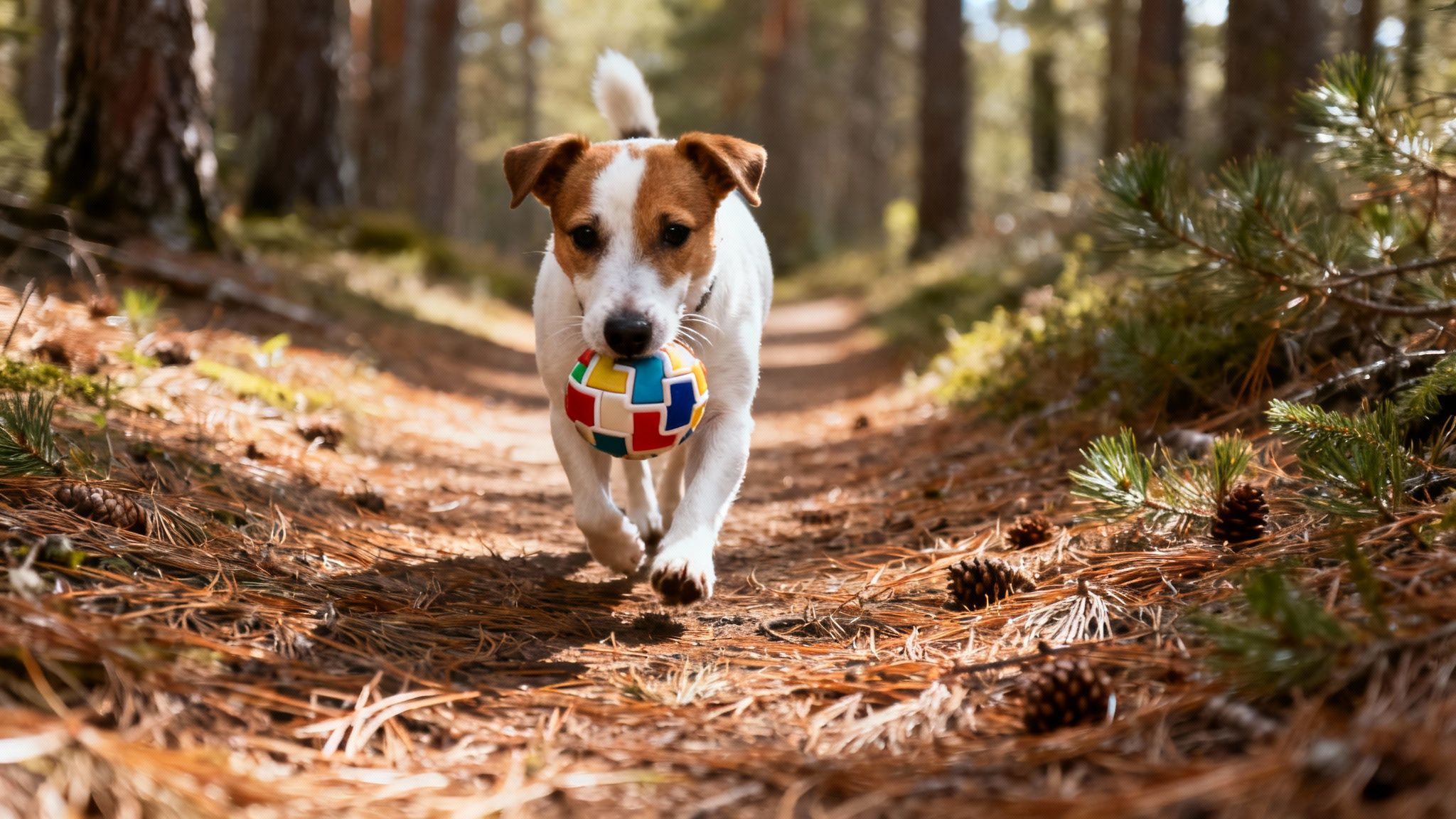Let's be honest: if you've come home to find the leg of your favourite chair looking like a beaver's breakfast, you're not alone. We've all been there. It’s a frustrating moment that every dog parent knows, but it's important to remember that chewing is a perfectly natural instinct for our dogs. When it’s your stuff, though, it’s a clear signal that something isn't quite right in their world.
To get a handle on this, we need a two-pronged approach. First, we'll immediately manage their environment to prevent them from practising the unwanted behaviour. Second, we'll give them a mountain of appropriate chew toys to satisfy that deep-seated urge. This combination helps you tackle the immediate problem while we figure out the root cause together, whether that’s a teething puppy, a bored adolescent, or an anxious companion.
Your Path to a Chew-Free Home
This guide is here to help you get to the 'why' behind the chewing. Together, we’ll dig into the usual suspects—from the discomfort of teething and the restlessness of an under-stimulated mind to the quiet stress of anxiety. We’re here to help you translate what your dog is trying to tell you with their teeth.
Moving Beyond Punishment
When you find your brand-new trainers in shreds, it’s so easy to react with frustration. But shouting or harsh corrections? They often do more harm than good. In fact, many well-meaning owners fall back on methods that can make the problem much, much worse.
The PDSA's Animal Wellbeing Report revealed that a staggering 15% of UK dog owners have used aversive methods like shouting to stop unwanted behaviours, with another 6% using two or more. You can dive deeper into these dog behaviour findings here. These approaches simply ramp up a dog's stress levels, which can—you guessed it—make the chewing even more frantic.
Instead, we’re going to focus on positive, practical strategies that build a happier, calmer home for everyone. The aim isn't just to save your furniture, but to build a stronger, more trusting bond with your dog along the way.
We believe in setting your dog up for success, not waiting for them to fail. By managing their environment and redirecting their natural instincts, you create a peaceful home where both you and your dog can relax.
This is a journey of understanding and patience. We’ll kick off with a quick-action plan to get the situation under control right now. For those moments you need an immediate fix, the table below summarises the first steps you should take.
Immediate Actions to Stop Destructive Chewing
| Action | Why It Works | Real-World Example |
|---|---|---|
| Interrupt & Redirect | This stops the unwanted behaviour without punishment and teaches your dog what they should chew on instead. | Your dog starts gnawing on the rug. Make a sudden but non-scary noise (like a clap or a sharp "Ah-ah!"), then immediately offer them a tasty, high-value chew toy. Praise them enthusiastically when they take it. |
| Dog-Proof the Area | By removing temptation, you prevent the behaviour from happening in the first place. This is management 101. | If you can't supervise your puppy, use baby gates to block off rooms with expensive furniture, or keep them in a crate or playpen with safe toys. Tidy away shoes, remote controls, and kids' toys. |
| Provide Better Alternatives | Your dog needs to chew. Giving them exciting, appropriate options makes your sofa seem boring by comparison. | Stuff a KONG toy with some of their kibble mixed with peanut butter and freeze it. This creates a long-lasting, mentally stimulating puzzle that satisfies their need to chew. |
Once you’ve got these immediate steps in place, we can dive into the long-term solutions. We'll explore how to get to the bottom of the behaviour and foster a healthier relationship with your four-legged friend for good.
Why Your Dog Chews Everything
To figure out how to stop your dog from chewing, we first need to put on our detective hats together. Every shredded cushion and gnawed table leg is a clue. It’s your dog’s way of communicating something important, and it’s rarely about just being naughty.
Chewing is a completely natural, hard-wired instinct for dogs. It’s how they explore the world, relieve stress, and even keep their jaws strong. Our job as their guardians is to work out why they’re choosing your expensive trainers over their own rubber bone.
Puppies and Teething Troubles
If you have a puppy, it's very likely their non-stop chewing is down to one thing: teething. Just like human babies, our pups go through a really uncomfortable phase when their adult teeth push through, which usually happens between three and six months of age.
The pressure from chomping down on something firm gives their sore gums some much-needed relief. They aren’t being deliberately destructive during this stage; they're simply trying to soothe an ache they can't understand. Our role is to provide them with safe and satisfying things to chew on to ease their pain, like a frozen carrot or a specially designed puppy teething toy.
This infographic breaks down the most common reasons why dogs resort to chewing, helping you pinpoint the likely cause.
As you can see, while teething is a huge factor for young dogs, boredom and anxiety are major culprits for dogs of all ages.
Adult Dogs and Deeper Reasons
Once your dog is past the teething phase, destructive chewing often points to an unmet need. This is where we need to look at the bigger picture of their daily life. Getting to the root of the behaviour is the single most important step toward finding a lasting solution.
Some of the most common triggers include:
- Boredom and Pent-Up Energy: A dog without a 'job' will often invent one, and redecorating the living room with their teeth can seem like a brilliant idea. A lack of physical exercise and mental stimulation is one of the biggest drivers of unwanted chewing.
- Anxiety or Stress: For a worried dog, chewing can be a self-soothing mechanism. We see this a lot in dogs with separation anxiety, who might chew frantically when left alone as a way to cope with their distress. Things like a change in routine, moving house, or even loud noises can trigger stress-related chewing.
- It’s Become a Game: Sometimes, our dogs learn to chew things simply because it gets a big reaction from us. If you jump up and chase them every time they pick up a shoe, it doesn't take long for them to turn it into a fantastic game of chase.
By observing when and where your dog chews, you can gather vital clues. Does it only happen when you're getting ready to leave the house? Or maybe it's in the evenings after they've not had a good walk? The pattern nearly always holds the answer.
On rare occasions, a sudden chewing habit in an adult dog can be linked to a medical issue, like dental pain or a nutritional deficiency. If the behaviour is new and completely out of character, a check-up with your vet is always a sensible first step to rule out any underlying health problems.
Creating a Dog-Proof and Dog-Friendly Space
Honestly, one of the kindest things we can do for our dogs—and our own sanity—is to set them up to succeed from the very beginning. Instead of just waiting for the inevitable chewed-up shoe, we can proactively manage our homes to make the right choice the easy choice. This isn't about turning your house into a sterile box; it's about creating a space that's both dog-proof and dog-friendly.
The idea is really quite simple. We remove the temptation of things they shouldn't chew while generously providing things they are absolutely allowed, and even encouraged, to get their teeth into. This simple shift changes the dynamic from a constant battle of "no!" to a peaceful environment where "yes!" is the default. It dials down the stress for everyone and helps your dog learn the house rules without conflict.
Managing the Environment to Prevent Chewing
Think of it like you would for a curious toddler. You wouldn't leave anything dangerous or valuable within their grasp, and the same logic applies perfectly to our dogs. It's all about being one step ahead.
To properly protect your belongings and, more importantly, your dog, it helps to be a bit systematic. In fact, many of the principles in a comprehensive guide to childproofing your home are just as relevant for our four-legged family members.
Start by getting down on your hands and knees to see the world from their perspective. What's within easy reach?
- Secure Electrical Cords: Let's tidy away all those loose wires from the TV, lamps, and phone chargers. You can use cord concealers or just tuck them safely behind heavy furniture. A chewed cord is a huge safety hazard.
- Relocate Valuables: That pricey pair of shoes, the TV remote, and your kids' favourite toys all need a new home, well out of reach. Think high shelves, cupboards, or behind closed doors.
- Use Physical Barriers: Baby gates are a dog parent's best friend. They're fantastic for sectioning off parts of the house you can't supervise, creating a safe zone where your dog can relax without getting into any trouble.
This isn't just anecdotal advice. Research shows that combining environmental management—using tools like crates and gates—with providing plenty of safe chew toys can dramatically reduce unwanted chewing. It’s a proactive strategy that genuinely works.
Before you set your dog loose with a new toy, you need to know what's safe and what's a hidden danger.
Safe vs Unsafe Chew Items for Your Dog
| Item Type | Safe Options (Examples) | Dangerous Items to Avoid |
|---|---|---|
| Household Items | Cardboard boxes (supervised), old towels for tug | Shoes, remote controls, socks, plastic bottles with caps |
| Natural Chews | Bully sticks, antlers (split, for moderate chewers), beef tracheas | Cooked bones (splinter easily), rawhide (choking hazard) |
| Toys | Hard rubber toys (like Kongs), puzzle feeders, durable rope toys | Soft plush toys with squeakers (can be ingested), tennis balls (abrasive) |
| Foods | Carrots, frozen bananas, apple slices (no seeds) | Grapes, raisins, onions, chocolate, anything with xylitol |
Remember, no chew toy is 100% indestructible. Always supervise your dog with a new item to make sure they're chewing safely and not swallowing large chunks.
Building a "Yes" Space
Dog-proofing is only half the story. The other, much more enjoyable part is creating an environment that’s incredibly enriching for your dog. Our goal is to make their approved toys far more interesting than the leg of your dining table.
This is where a designated "yes" space comes into play. It could be a specific corner of the living room, their cosy crate, or even a playpen. This area should be well-stocked with a rotating selection of fantastic, dog-approved items.
Your goal is to make your dog's toys and chews so appealing that your furniture becomes completely boring by comparison. A well-stocked 'yes' space redirects their natural chewing instinct onto things that are safe and fun.
Stock this area with a variety of textures and challenges to keep them engaged. Look for durable rubber toys that can be stuffed with food, puzzle feeders that make them use their brain, and safe, natural chews. For instance, our guide to the best dog toys by KONG has some brilliant ideas to get you started.
By making their space a treasure trove of fun, you’re not just stopping bad habits; you’re building a happier, more fulfilled dog.
Positive Training to Redirect Chewing
Now that your home is a safe, temptation-free zone, we can get to the really rewarding part: teaching your dog what you want them to do instead. This is where positive reinforcement training comes in. It’s not just about stopping a bad habit; it’s about building your dog’s confidence and strengthening your bond, making you the most exciting thing in their world.
Forget harsh corrections or telling-offs. We’re going to turn this into a series of fun games. This approach makes learning enjoyable for your dog and helps them understand the house rules without feeling anxious or confused.
Our goal is simple: to make their approved chew toy far more interesting than your new trainers.
Teaching the "Leave It" Cue
One of the most valuable skills you can teach your dog is a reliable "Leave It" command. Think of it as a safety net that stops them from picking up everything from a dropped piece of chocolate to something nasty on a walk.
More importantly, in this context, it gives you a clear, calm way to say, "Not that one, this one instead."
We'll start this in a quiet, low-distraction environment, like your living room.
- The High-Value Trade: Place a low-value treat (like a piece of their normal kibble) on the floor and cover it with your hand. The moment your dog sniffs or licks your hand, say "Yes!" and reward them with a much better, high-value treat (like a tiny piece of chicken) from your other hand. Repeat this until they automatically look to you for the better treat after sniffing your hand.
- Adding the Cue: Once they understand the game, start saying "Leave it" in a calm, upbeat tone as you cover the kibble. When they back away from your hand and look at you, praise them enthusiastically and give them the high-value reward.
- Increasing the Challenge: Gradually make it harder. Uncover the treat on the floor but keep your hand poised to cover it. If they move towards it, simply cover it and wait. The moment they hesitate or look at you, it’s a jackpot of praise and tasty treats.
This game teaches them that ignoring something on the floor leads to a much better reward from you. It builds brilliant self-control and shows them that listening to you is always worth their while.
What to Do When You Catch Them Chewing
It’s going to happen. You’ll turn around to find your dog with a shoe in its mouth. How you react in this split second is crucial.
Shouting or chasing them often turns the situation into a thrilling game of keep-away, which accidentally reinforces the very behaviour you want to stop. Instead, let's stay calm and follow a simple redirection strategy.
The key is to interrupt, not intimidate. A quick, sharp but non-scary sound like a clap or a short "Ah-ah!" is usually enough to get their attention. The instant they drop the forbidden item, you need to be ready with an amazing alternative.
Swap the shoe for something irresistible, like a puzzle toy filled with their favourite paste or a really smelly natural chew. When they take the approved toy, shower them with praise.
You’re teaching them a clear lesson: "When you chew this, good things happen. When you chew that, the fun stops." This positive approach is at the core of effective training and can help you build a brilliant relationship. To learn more about the fundamentals, you can find a great overview of how to train a dog with positive methods.
By consistently applying these techniques, you’re not just managing a problem; you’re communicating with your dog in a language they understand. You're showing them the path to making good choices, which builds a foundation of trust that will last a lifetime.
The Power of Enrichment and Exercise
You’ve probably heard the old saying, "a tired dog is a good dog." There’s a lot of truth in that, but we like to take it one step further: a fulfilled dog is an even better one.
When our clever dogs have nothing to occupy their minds or bodies bursting with unspent energy, destructive chewing often becomes their new, self-appointed job. This is where we need to step in and meet their needs for both physical and mental stimulation. When we do that, our furniture suddenly becomes far less interesting.
This is about more than just a quick trot around the block. It’s about truly understanding what your dog needs to feel satisfied. Different breeds have wildly different requirements; a Border Collie’s needs are a world away from those of a Basset Hound. A lack of appropriate outlets is one of the main reasons vets see so many young dogs for destructive behaviours.
More Than Just a Walk
Let’s turn that daily walk from a quick toilet break into a proper sensory adventure. One of the best ways to tire out a dog is to let their nose do the work. We're big fans of the 'sniffari,' where you let your dog lead the way, sniffing every post and patch of grass they fancy. Sniffing is incredibly calming and mentally taxing for dogs—it can be far more exhausting than a brisk jog.
For our younger dogs, it's also crucial to get the balance right to protect their developing joints. If you're wondering what’s appropriate for your pup, our guide on how much exercise a puppy needs to be healthy has some really useful insights. A good mix of structured lead walks and off-lead fun in a secure area gives them the variety they crave.
The Magic of Mental Stimulation
Physical exercise is only half the battle. A smart dog left to their own devices will inevitably find something to do, and that’s when your favourite shoes or the corner of the sofa are at risk. This is where enrichment comes into play—it's all about giving their brain a proper workout.
Enrichment doesn’t have to be expensive or complicated. You can make a huge difference with simple, budget-friendly ideas you can start today:
- Puzzle Toys: These brilliant toys require your dog to solve a problem—like nudging, rolling, or sliding a piece—to get a treat. They are fantastic for building confidence and beating boredom.
- Scent Games: Simply hide a few smelly treats around a room and encourage your dog to "find it." This taps directly into their natural foraging instincts and is a great rainy-day activity.
- Lick Mats: Spreading some dog-safe peanut butter or pâté on a textured mat encourages licking, which is a natural self-soothing behaviour that can really help reduce anxiety.
By providing a healthy mix of physical exercise and brain games, you're fulfilling your dog's needs on a much deeper level. A dog who has spent their day sniffing, thinking, and playing is a dog who is happy to settle down and relax—too content to even think about chewing the sofa.
Your Dog Chewing Questions Answered
Even with the best plan in place, we know that every dog's situation is a bit different. You’ve done the hard work of dog-proofing your home and starting the training, but specific questions always seem to crop up. We get it, and you’re not on your own with this.
This last section is all about tackling some of the most common questions we hear from dog parents just like you. Think of it as a troubleshooting guide to help you fine-tune your approach and feel confident again.
Why Has My Adult Dog Suddenly Started Chewing?
It can be really unsettling when a perfectly well-behaved adult dog suddenly starts destroying things. A sudden change in behaviour like this is a huge red flag that something has shifted in their world, and it’s our job to play detective together.
Often, the trigger can be something in their environment. Have you changed your work schedule recently? Has a new person or pet moved into the house? Even small disruptions can bubble up as stress, which often comes out in the form of chewing.
Before we jump to conclusions, though, we must rule out any physical discomfort. A sudden, frantic urge to chew can be a strong indicator of dental pain from something like a cracked tooth or sore gums.
Before you focus on behavioural fixes, a trip to your vet is crucial. A quick check-up can rule out any underlying medical issues, making sure you're tackling the real root of the problem.
Do Anti-Chew Sprays Actually Work?
Bitter-tasting sprays can feel like a tempting quick fix, and they definitely have their place as a management tool. The idea is simple: you make an off-limits item, like a table leg, taste absolutely disgusting so your dog learns to leave it alone.
While they can be helpful, they are not a long-term solution on their own. Some dogs, bless them, just don't seem to mind the taste, and others will simply find something else to chew on that hasn't been sprayed. They work best as a temporary deterrent while you actively teach your dog what they should be chewing on instead.
If you decide to give one a try, always choose a formula that is specifically designed to be pet-safe. And remember to pair it with positive redirection—always have a fantastic, high-value chew toy ready to offer as a brilliant alternative.
What If My Dog Only Chews When I’m Gone?
This is one of the most common and heartbreaking chewing problems we come across. It's a classic sign of either separation anxiety or just profound boredom. Coming home to destruction is incredibly frustrating, but it's so important to understand that your dog isn't doing it out of spite.
Telling them off after the fact is completely pointless, as they won't be able to connect your frustration with something they did hours ago. The solution lies in getting to the root of why it's happening.
- For Boredom: Leave them with a "work-to-eat" puzzle toy, like a frozen KONG or a snuffle mat. These things keep their brain busy and give them a job to do while you're away.
- For Anxiety: This needs a more delicate approach, focused on building their confidence. Practise short, calm departures and arrivals. Make sure they get plenty of exercise before you leave to help them settle down more easily.
Tackling this behaviour is all about helping your dog feel safe and secure when they're by themselves, turning their alone time from a stressful event into a peaceful naptime.
At K9 Time, we understand that every dog is an individual with unique needs. If you're struggling with chewing or other behaviours in the Sheffield area, our one-to-one dog walking and pet care services can provide the exercise and mental stimulation your dog needs to thrive. Learn more about our personalised approach at https://k9time.co.uk.





